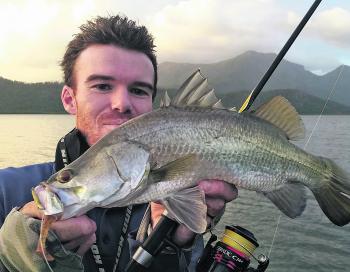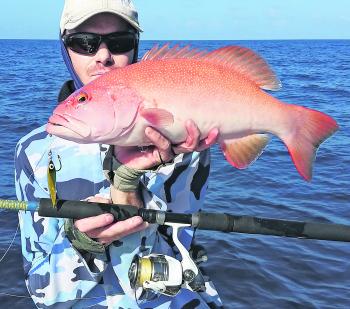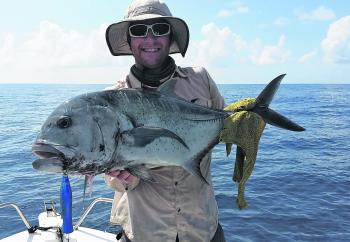Wintertime in the tropics… it seems strange even typing that as so far we haven’t even seen a glimmer of winter. The water has cleared up a lot and the water temperature is down, but we have had humid days, storms and afternoon northerly sea breezes very similar to summer months.
The benefit of this is the fact that the barramundi have continued to happily feed and not bury their heads in the mud as usual in the cold. The waters around Lucinda are an angler’s dream come true at the moment, as all the species are on the cards. It is quite possible to head out in the morning and chase some mackerel and red fish then after lunch chase barra and jacks in the creeks.
At the moment the channel is offering some excellent fishing for a range of species. Although the water temperatures have dropped and the water is clearer, there has still been good captures of barra for those fishing the days with bigger tides, especially in the afternoons.
The better areas to target will be the gutters and drains that have close proximity to a shallow sand or mud flat. The reason for this is simply that those shallower spots will hold warmer temperatures and warmer water ad that means there is a chance barra will be feeding.
Small offerings in both live baits and lures seem to get more interest. The most annoying thing about live baiting for barra during winter is the aggressive pikey bream that hunt in massive packs and will kill and rip apart the biggest of mullet. If the bream find you, it’s nearly worth moving spots as they will deplete your stock of livies very quickly.
Blue threadfin salmon will be on the move as well in the creeks. Early morning sessions can be magic when you can find a big school. I find the creeks that have sand banks over mud seem to hold better schools of blue salmon.
I would suggest chasing them around the incoming tide when it’s half way in, just be quiet and keep your eyes peeled as the schools can be easily seen rippling over the shallows. It is very hard to beat sneaking up on a school and throwing small lures and plastics into them, seeing them turn on your lure and race each other to smash it is.
Silver grunter will also be about for the bait anglers fishing the mouths of creeks. Grunter bite all day, but the best sessions are normally during the night, where they feed actively over the flats. Best baits are prawn, sardines or squid and should be fished light.
One word comes to mind when you talk about fishing tropical waters during winter. Fun! There will be packs of queenfish ready and waiting on the jetty, and they should be schooled up and ready to rip some drag and get some serious airtime. The resident jetty GT seem to also get angrier when it’s cold, and will be the reason plenty of anglers are back re-stocking their tackle boxes.
The Palm Islands will hold good schools of Spanish mackerel, so those with smaller boats don’t need to head to the reef to find them. The northern point of Pelorus Island is a known hot-spot and early morning or evening sessions trolling around the current lines will see rods getting bent.
The main secret to getting amongst the mackerel is to locate the bait schools. If you can find bait, then the mackerel won’t be far off. Trolling hardbodied lures that dive deep and can be trolled at around 6-10km/h are needed. There is no need for wire when trolling, as it will give you less strikes and most of the time the lure will protect your leader. If you do want to use a wire trace, I would suggest making your own out of nylon-coated wire.
The reef will be on fire and as the water is cooler, the trout can be found up in the shallows in better numbers. One of my favourite ways of chasing trout is to set up a drift over some good bottom and work plastics and micro-jigs. You need to be on the ball, as you need to keep your offering close to the bottom to get strikes but not get snagged. Keeping a good eye on your sounder is important, as it can help to avoid the snagging that is inevitable. You can also use lighter gear so that even the many by-catch species you will get are good fun.
Out in the deep the big red fish will be hungry as usual, and dropping some big slab baits around sunset over a deep rubble patch or rock should see the back getting a work out. If you can beat the fish and the sharks you will be eating well for weeks.
It is also the time of year that the smaller black marlin are about, so for the very few who put in the time should be rewarded with a fish of a lifetime. It is always worth throwing out a couple of pushers (skirted lures) when moving spots, as you never know what you may get interested.
Reads: 1795
Barra don’t go anywhere during the winter, they just become harder to tempt.

Micro-jigging trout is a fun way to get a feed.

GTs will always eat, even if it’s only out of anger.




